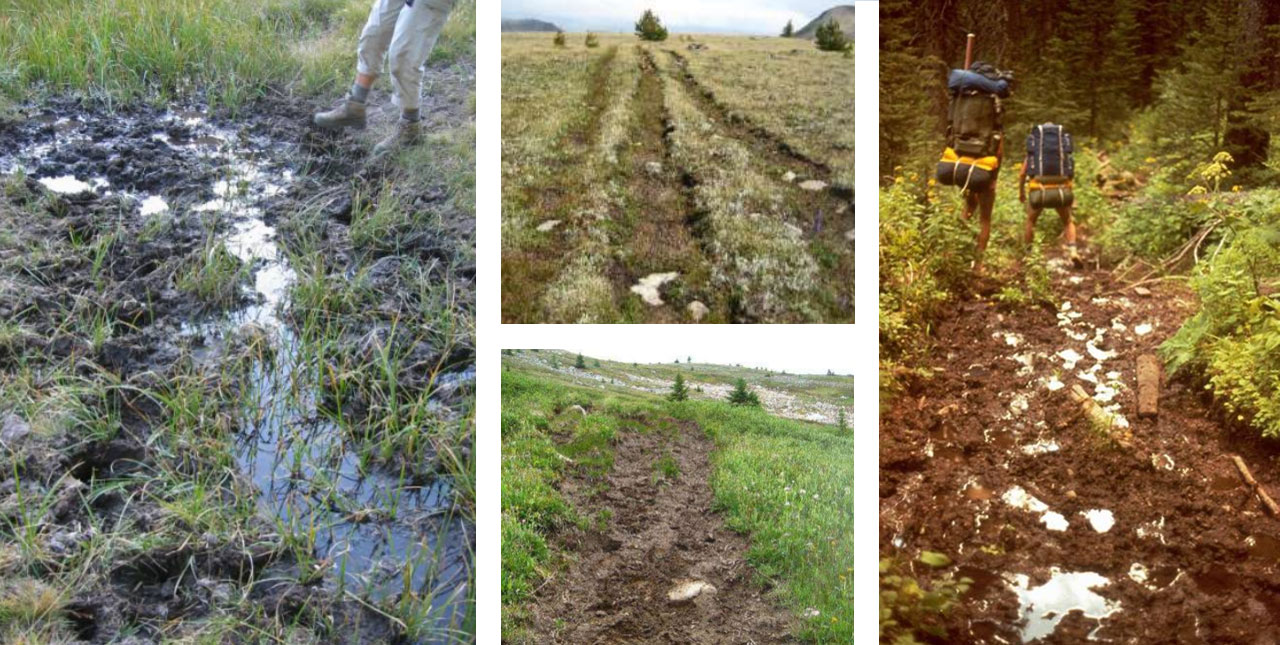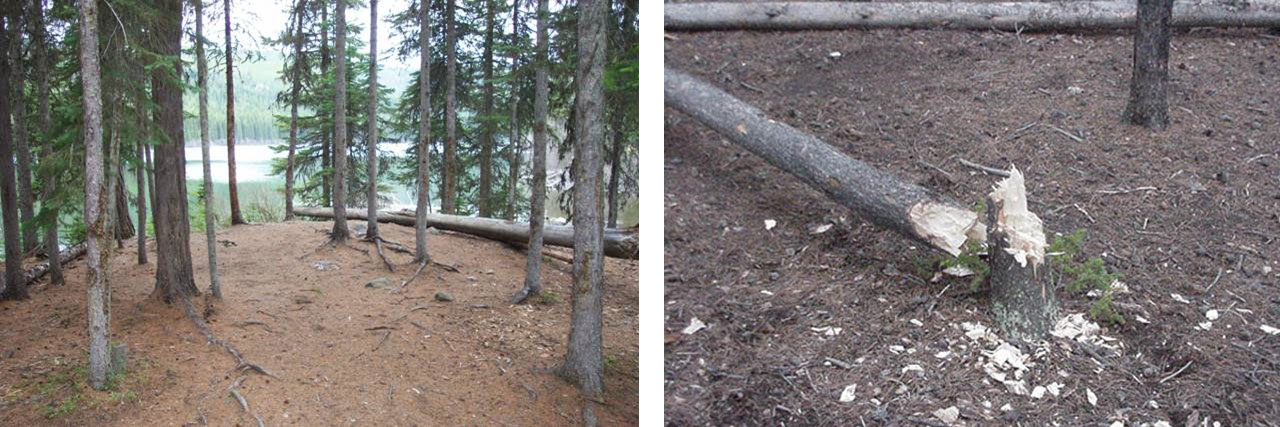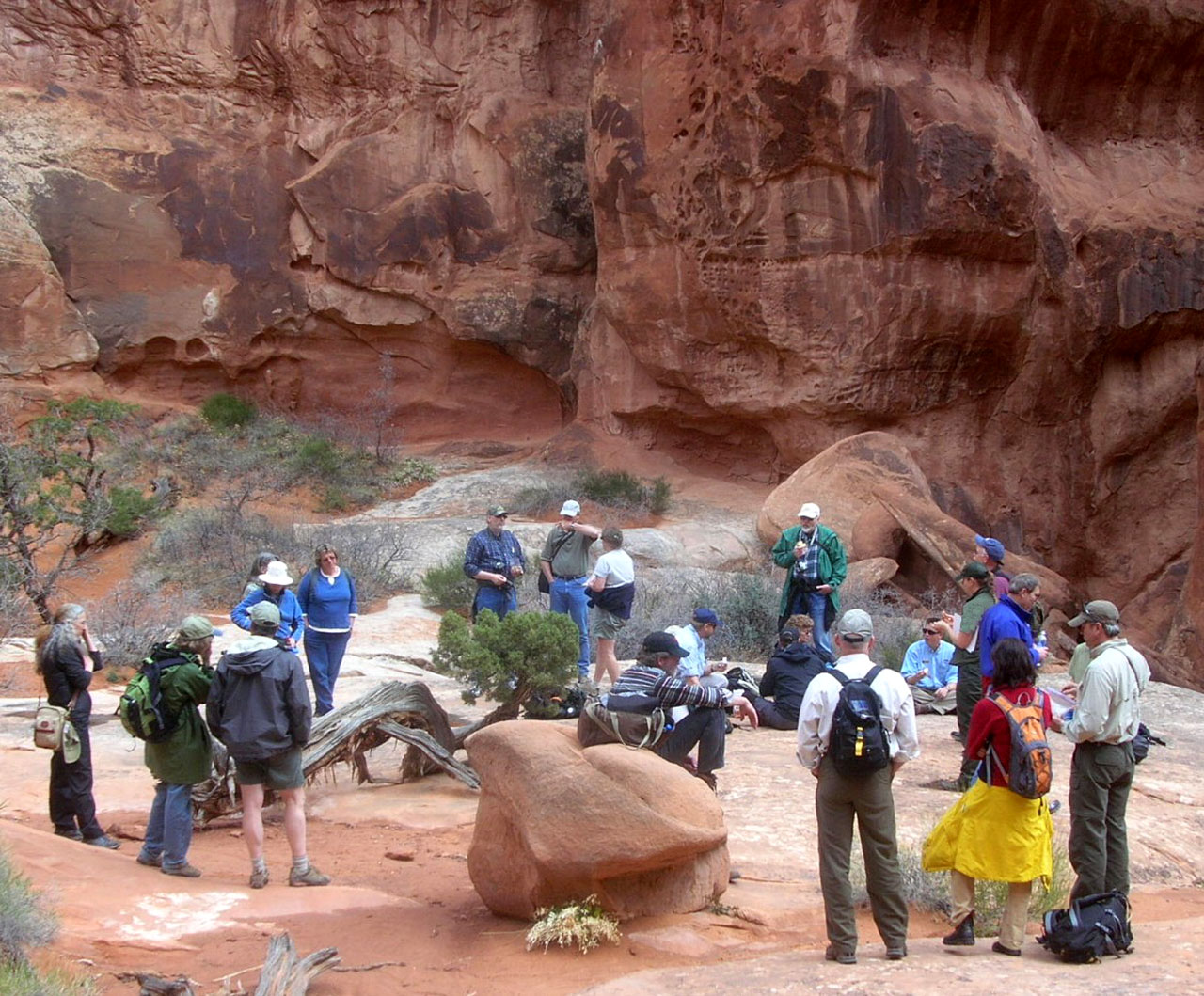Overuse
Heavy Footprints: Impacts to Wilderness from Overuse or Ecologically Insensitive Use
The Wilderness Act of 1964 gave land managers a difficult and challenging mandate. Wilderness areas are to be kept in a wild and natural state—relatively free of human control—while, at the same time, providing for their use and enjoyment. Excessive visitation to wilderness has the potential to degrade the landscape and its ecosystem processes—the oft-raised concern that a place is “being loved to death”—as well as detract from the human-oriented wilderness experience.
The first survey on outdoor recreation was done in 1960. Since then, outdoor recreation has been increasing dramatically, driven primarily by the growth of the U.S. population by over 100 million in just over 40 years. Participation in canoeing and kayaking, for example, grew from 2.6 million in 1960 to 15 million in the early 1980s to 28 million by 2000; participation in day hiking and backpacking has increased by 194% and 182%, respectively, since the early 1980s. Wilderness visitation has also increased, almost six fold, according to agency estimates, between 1965 and 1994.
Between 1999 and 2009, the number of people visiting wilderness areas increased by nearly 18%, with a 32% increase in total visitor days. Although a Forest Service projection suggested a decline in per-capita wilderness visitation between 2008 and 2030, actual numbers of participants are forecast to rise by 24%. This predicted increase may indeed be early, due to the pandemic of 2020. 'Wreakreation,' as some call the damage from simply too many people, has become a real concern.
It should be pointed out that a wilderness needn't be “overused” to suffer from visitor impacts: a small number of outdoor recreationists who fail to practice Leave No Trace principles—say, by traveling and camping on vulnerable surfaces such as lakeshore vegetation or cryptobiotic soil, trashing campsites or fouling water sources—can leave quite the mark on even a lightly-visited wilderness.
Changes in Wilderness Visitation
In addition to increases in outdoor recreation participation and wilderness visitation, the typical wilderness visit is also changing. Wilderness visitor groups are getting smaller, typically ranging from 2-5 people; lengths of stay are getting shorter, with day use being the most common type of wilderness visit; and many people are now choosing to visit wilderness areas closer to their home or in their home state.

This map shows wildlands and their proximity to cities. Nearly 80% of America's largest cities are within 100 miles of at least one wilderness area.
Biophysical Impacts from Visitors
Research has shown that recreation can impact both biophysical and social aspects of wilderness. Common biophysical impacts include trampling, campfires and wood collection, tree damage, wildlife disturbance, trash, and human feces. Overall, Leave No Trace education plays an important role in helping visitors understand how they can minimize their biophysical impacts when recreating in wilderness.
Trampling
Perhaps the most common type of biophysical impact is trampling, which is caused by the footsteps of hikers and pack stock. This can damage or kill plants, compact soil, and increase erosion. The footfall of a hiker exerts some 4.2 pounds per square inch of ground pressure; a shod and mounted horse some 62.3 pounds per square inch.
Not all vegetation is equally vulnerable to trampling: With their soft stems and low-set perennating buds, graminoids (grasses and sedges) tend to be more resilient than more brittle woody plants and tall forbs. Hikers and stock may therefore wield somewhat less of an impact on a grassy meadow than on the forb- and shrublet-carpeted floor of a wood.
Trampling research shows that small amounts of use generally cause substantial impact, while additional use increases impacts much less. Site durability also plays an important role in how well areas resist impacts.
A study of campsites in Wyoming's Popo Agie Wilderness exemplifies both of these statements. In this study, researchers found that camping for one night in a previously unused forested area eliminating 60% of the vegetation, while four nights eliminated 80%. On neighboring meadow campsites, however, four nights of camping had no effect on the vegetation during the first year of use. Degradation started to occur during the second year with vegetation loss of less than 20% and no further loss occurred during the third year.
Research also shows that recovery rates for highly trampled areas are variable but are almost always slower than rates of deterioration. For example, impacts of trampling are still visible 30 years after experiments were conducted in alpine vegetation in Glacier National Park, while in contrast, evidence of camping in closed riparian campsites at Delaware Water Gap disappeared after only six years.
Not surprisingly, larger groups of people create larger impacts, and pack stock generally create more trampling impacts than hikers. Of particular interest in grazing areas is trampling damage done to wet meadows by pack stock. In many cases, pack stock are prohibited from grazing during wet seasons to minimize trampling impacts.

If excessive trampling causes dieback of groundcover, it may eventually hasten the removal of duff, humus, and ultimately organic soil, exposing underlying mineral soil to compaction. This can impede seed germination and water infiltration.
Although trampling, to some extent, is an unavoidable and tolerated consequence of the Wilderness Act's mandate to provide for the use and enjoyment of wilderness by all Americans, campsite and trail impacts have increased greatly over the past several decades, primarily due to the creation of new campsites and trails rather than the recovery of existing ones. For example, the number of campsites increased by 53% in the Selway-Bitterroot Wilderness between 1977 and 1989, 84% in the Lee Metcalf Wilderness between 1975 and 1990, and 123% in the Eagle Cap Wilderness between 1972 and 1988.
Common strategies to minimize trampling impacts include: concentrating use on existing trails and campsites; discouraging shortcutting and creation of social trails; requiring camping on designated campsites in areas that receive extremely high use; distributing low levels of use in extremely durable areas (for example, rocky or grassy areas that resist impacts); or discouraging use of certain areas when they are wet and more prone to erosion or relocating trails to prevent erosion.
Campfires
Other types of biophysical impacts include campfires, which sterilize soil and consume local wood that might otherwise contribute habitat and decomposition energy to the ecosystem. This makes it critically important to confine fires to existing fire rings or, in some cases, to prohibit or discourage campfires in areas where firewood is minimal, such as in high-elevation whitebark-pine stands in the West. With options such as lightweight LED lanterns, visitors can choose to enjoy evening light without a campfire.
Tree Damage

Wood collection for campfires depletes woody debris that serves to nurture new vegetation growth in and around campsites. For example, research in Oregon wildernesses showed an average 40% reduction in woody material 30 to 45 feet from the center of campsites. To minimize wood collection impacts, managers discourage live tree cutting, recommend leaving large downed woody debris alone and burning only downed wood that can be broken by hand. Wood collected for campfires should be 'Downed, Dead and Dinky.' Tying pack stock can also damage or kill live trees. Hitch rails, or corrals, are sometimes found in wilderness and serve to both keep stock away from trees and concentrate their trampling impacts into small areas.
Wildlife Disturbance
Wilderness visitors can also directly disturb wildlife, either intentionally—through hunting, trapping, fishing or fish stocking, for example—or unintentionally. Trash, including food, and habitat modification, such as firewood collection, can affect small mammals and bird populations by changing food sources and shelter options. Off-season use of wilderness can be particularly taxing for wildlife. Several studies, for example, have documented elk disturbance in winter by cross-country skiers. As such, some wilderness areas are closed—partially or entirely—during nesting, breeding or critical feeding times. Part of Florida's Cedar Keys Wilderness, for example, is closed to public entry from March 1 through June 30 to protect colonial nesting birds.
Trash
Unfortunately, wilderness visitors often leave trash and other human waste in wilderness. Although it is a generally accepted practice to bury human waste in catholes, some heavily used areas, such as Mount Adams in the Mount Adams Wilderness, now highly recommend or require the use of portable personal waste disposal systems, such as Wag Bags. As visitor numbers increase, more wilderness areas may require human waste to be packed out. There is little excuse for leaving trash in wilderness, however, since Leave No Trace recommends that visitors who pack-it-in also pack-it-out.

Trash comes in all shapes and sizes and is removed by rangers or volunteers from nearby communities.
Social Impacts from Visitors
Biophysical impacts to wilderness are sometimes more visible than social impacts. However social impacts can pose significant threats to the quality of visitor experiences. Social impacts include crowding, loss of solitude, and conflict.
Crowding and Loss of Solitude
Crowding and loss of solitude are important impacts to the social aspects of wilderness that can occur from recreation. Although visitor experiences are complex, encounter monitoring is often used as a measurement technique for understanding social impacts since encounters, both on trails and at campsites, are an important determinant of experiencing solitude in wilderness. For example, 68% of hikers surveyed at trailheads in the Shenandoah Wilderness indicated that seeing a few or no other groups contributed to a sense of solitude.
Survey respondents in the Alpine Lakes Wilderness and Three Sisters Wilderness indicated that lack of encounters, particularly at campsites or rest areas, added greatly to the sense of having a real wilderness experience. This study also suggests that the effects of increasing encounters are more pronounced on moderate-use trails than on high-use trails. Indeed, when faced with crowding, users desiring high levels of solitude are often displaced from high-use locations. For example, 13% of respondents surveyed in 19 Oregon and Washington wildernesses could identify at least one place within a wilderness to which they would not return, with crowding being the most cited reason.

Research suggests, however, that the majority of wilderness visitors are adaptable. In studies of high-use locations in Oregon and Washington wilderness areas, researchers found that although wilderness visitors do care about how many other people they encounter, "they learn; they plan; they adjust their expectations; they cope; they rationalize; they view things in relative terms—rather than in absolutes—they say 'this place provides more solitude...' rather than 'this place provides no solitude'; they make trade-offs. They adapt." As such, management actions that limit access, such as the institution of use limits, are not widely supported when proposed for the purposes of maintaining quality visitor experiences rather than to mitigate biophysical impacts.
Conflict
There is also recognition that visitor density is not the only factor affecting the social aspects of wilderness. Different user groups often have contrasting views on wilderness values, and types of encounters, not just numbers, can lead to conflicts. Much of the research on conflict in wilderness has centered on conflicting recreational uses, such as conflicts between hikers and stock users, private and commercial rafters, hunters and non-hunters, solitary and social outdoors-people, or visitors with and without dogs.
In some cases, conflict between user groups is asymmetrical, or one sided. For example, while only 4% of John Muir Wilderness stock users disliked their encounters with hikers on a specific trip, over one-third (36%) of hikers who met horses disliked the encounters. Conflict occurs due to differences in four ways to describe wilderness visitors.
|
Visitor Differences |
Definition |
Example |
|---|---|---|
|
Activity Style |
The various personal meanings assigned to and the intensity with which visitors participate in selected activities. |
An angler who places high importance on tying flies and luring wild cutthroat trout to a barbless hook will likely experience conflict with spinning or bait anglers sharing the same resource. |
|
Resource Specificity |
The significance attached to using a specific place or resource for a given recreational experience. |
Mountain bikers in Montana's Rattlesnake National Recreation Area were more dependent upon the place than hikers because they reported fewer substitutes for the kind of biking they liked to do there than hikers reported. |
|
Mode of Experience |
The varying expectations of how the natural environment is perceived or the focus of a given recreational experience. |
Mountain bikers at the Rattlesnake National Recreation Area were found to be most focused on the activity itself, while the hikers who were feeling conflict were more focused upon their social group or the environment. |
|
Lifestyle Tolerance |
The tendency to accept or reject lifestyles different from one's own and believe in stereotypes. |
Private rafters on Idaho's Salmon River may experience conflict when encountering commercial rafters if they know or believe that commercial rafters: are the dominant user on that river; tend to have much higher annual household incomes; are generally novice river floaters; have high expectations for nature but attach low value to solitude; tend to come from distant large urban centers; and do not have to compete in a lottery system like private floaters to obtain a permit. |